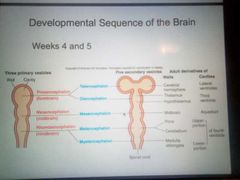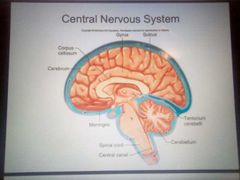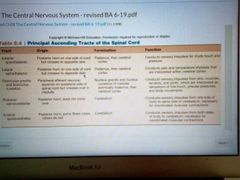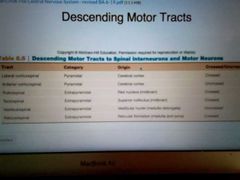![]()
![]()
![]()
Use LEFT and RIGHT arrow keys to navigate between flashcards;
Use UP and DOWN arrow keys to flip the card;
H to show hint;
A reads text to speech;
47 Cards in this Set
- Front
- Back
|
3 primary vesicles |
Prosencephalon - forebrain Mesencephalon- midbrain Romnencephalon- hindbrain |
|
|
5 secondary vesicles |
Telecephalon, diencephalon Mesencephalon Metacephalon, Mylencephalon |
|
|
Cerebrum - 5 lobes |
Frontal Parietal Occipital Temporal Gyri of insula |
|
|
Frontal and Parietal Lobes are separated by the |
Central sulcus |
|
|
Precentral gyrus is located and Is responsible for? |
Frontal lobe and responsible for motor control; neurons called upper motor neurons. |
|
|
The Postcentral gyrus is located and is responsible for? |
Is in the Parietal lobe and is responsible for somatesthetic sensation ( coming from receptors in the skin, muscles, tendons, and joints); called the somatosensory cortex. |
|
|
Primary Motor Cortex |
Precentral gyrus in frontal lobe If something is wrong with this then won't be able to move. |
|
|
Primary Somatosensory Cortex |
Sensation- Postcentral gyrus |
|
|
Temporal lobe |
Auditory centers; storage (memory) of auditory and visual experiences. |
|
|
Occipital lobe |
Vision and coordination of eye movements. |
|
|
Insula |
Encoding of memory and integration of sensory information with visceral response; receives olfactory, gustatory, auditory, and pains information. |
|
|
Cerebral Cortex |
1) The outer region of the cerebrum composed of 2-4mm gray matter with underlying white matter. 2) Characterized by raised folds called gyri separated by depressed grooves called sulci; together called convolution. 3) Each hemisphere is divided by deep sulci or fissure into 5 lobes - Frontal, Parietal, Temporal, Occipital, Insula. |
|
|
Frontal lobe |
Voluntary motor control of skeletal muscles; personality; higher intellectual process ( concentration & decision making ) verbal communication. |
|
|
Parietal lobe |
Somatesthetic interpretation (e.g. cutaneous and muscular sensation); understanding speech and formulating words to express thoughts and emotions; interpretation of textures and shapes. |
|
|
Speech |
a) To speak, word comprehension originates in Wernicke's area and is sent to Broca's area along the arcuate fasciculus. b) Broca's area sends information to the motor cortex to direct movement of appropriate muscles. |
|
|
Diencephalon is divided into 3 parts |
Thalamus Epithalamus Hypothalamus |
|
|
Thalamus |
Relay center |
|
|
Epithalamus |
Contains the choroid plexus over 3rd ventricles where cerebrospinal fluid is produced Also contains Pineal glands=secrete melatonin=> helps regulate circadian rhythms. |
|
|
Hypothalamus |
Regulate s Blood pressure, respiratory rate, temperature Mood, appetite,thirsty, homeostasis-> boss of endocrine system 1) ADH 2) oxytocin |
|
|
Pituitary gland |
ADH & oxytocin are transported along the the hypotalamohypophyseal tract to the posterior pituitary gland, where they are stored until needed. |
|
|
Brain stem has 3 parts |
Midbrain Pons Madulla oblongata ** Keeps you alive = cardiovascular & respiratory |
|
|
Cerebellum |
Second largest structure; gray matter outside white matter inside Receives input from proprioreceptors in joints, tendons, and muscles Works with the basal nuclei and motor cortex to coordinate movement. The cerebellum is needed for motor learning and the proper timing and force required to move limbs in a specific task. |
|
|
Central Nervous System |
Composed of brain & spinal cord |
|
|
Embryonic Development |
From ECTODERM comes a groove that will become the NEURAL TUBE around 20 days after conception. This will eventually become the CNS. Between the neural tube and the developing epidermis,NEURAL CREST forms. This will become PNS ganglia. By week 4 after conception, three distinct swellings are seen on the neural tube. PRIMARY VESICLES. a. Prosencephalon (forebrain) b. Mesencephalon (midbrain) c. Rhombencephalon (hindbrain) By week 5, these regions differentiate into five regions. FIVE SECONDARY VESICLES. a. Prosencephalon (forebrain)=> Telencephalon and Diencephalon.b. Mesencephalon (midbrain) => midbrainc. Rhombencephalon (hindbrain) => Mesencephalon and myelencephalon. |
|
|
Developmental Sequence of the Brain |

|
|
|
Central Nervous system |

|
|
|
Later development of embryo Telencephalon=> |
2 cerebral hemisphere & 2 lateral ventricles |
|
|
Later development of embryo Diencephalon => |
thalamus, hypothalamus, & 3rd ventricle |
|
|
Later development of embryo Mesencephalon=> |
Midbrain & cerebral aqueduct |
|
|
Later development of embryo Metencephalon |
Pons, cerebellum, upper 4th ventricle |
|
|
Later development of embryo Myelencephalon=> |
Medulla oblongata & lower 4th ventricle. |
|
|
Later development of embryo Posterior neural tube => |
Spinal cord |
|
|
Mirror neurons are found in and are for |
In frontal & Parietal lobes Integrate sensory & motor neural activity Connected through the insula and cingulate gyrus to emotion centers in the brain. May be involved in the ability to learn social skills & language. Have been implicated in autism (autism spectrum disorder). |
|
|
Sleep maybe be genetically controlled, although sleep is affected by environmental factors. NT involved |
Histamine - wakefulness Adenosine & GABA- sleep Serotonin- induces REM sleep and stimulates non- REM sleep. |
|
|
REM |
Rapid eye movement - dreams occur=> theta waves |
|
|
Non- REM |
Resting sleep; 4 stages (stage 3 & 4~ slow wave sleep, Characterized by Delta waves |
|
|
Broca's Area |
Left inferior frontal gyrus Broca's aphasia involves slow, poorly articulated speech. There is no impairment in understanding. Interestingly- other actions of the tongue, lips & larynx are not affected; only the production of a is affected. Controls motor aspect of speech. |
|
|
Wernicke's area |
Left superior temporal gyrus Wernicke's aphasia involves production of rapid speech with NO MEANING, called "WORD SALAD" Language (spoken and written) comprehension is destroyed. Controls understanding of words. Information about written words is sent by the occipital lobe (visual cortex) |
|
|
To speak |
Word comprehension originates in WERNICKE'S AREA and is sent to BROCA'S AREA along the arcuate fasciculus. BROCA'S area sends info to motor cortex to direct movement of appropriate muscles. |
|
|
Angular gyrus |
At the junction between the Parietal, occipital, and temporal lobes. Center for integration of sensory information Damage here also produces aphasia involved in reading and writing |
|
|
All ascending and descending tracts between the brain and spinal cord pass through the ____ |
Medulla oblongata |
|
|
Principal ascending tracts of the spinal cord |

|
|
|
Descending Motor Tracts |

|
|
|
Cranial nerves |
CNI olfactory CN II Optic CNIII CNIV CNV trigiminal sensory/ motor chewing CNVI eye movement CN VII facial, mixed nerve CN VIII vestibula choclear CNIX gag reflex CN X vagus gag reflex CN XI accessory CN XII hypoglossa |
|
|
Difference between somatic and autonomic |
Somatic motor neurons have a cell bodies in spinal cord and just one neuron on traveling from spinal cord to effector Autonomic motor system has two sets of neurons in the PNS 1st has fell bodies in the brain or spinal cord and Synapses in a autonomic ganglion. The second has cell bodies in the ganglion and Synapses on the effector. |
|
|
Somatic motor neurons |
Release only acetylcholine which is always excitatory. |
|
|
Autonomic neurons |
Release mainly acetylcholine and norepinephrine but may be excitatory or inhibitory. |

